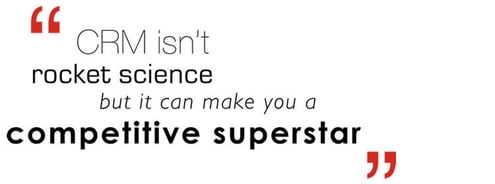Most bits of new technology these days simply don’t come with a fully loaded instruction manual like the technology of yesteryear. The software and technology we use today is often intuitive enough that we can log in, acclimatize ourselves to the basic interface and we’re flying within a matter of moments.
But there’s a difference between simply using a system ‘out of the box’ as it were and using it well. Take a customer relationship management system (CRM) for example. While it doesn’t take a genius to work out how much value such a tool can bring to the table, it’s a completely different challenge to work out what the best practices for using a CRM system are.
We were rather intrigued to understand just what makes any CRM user excel so we took some time to pick the brains of a man in the know: Neil Saviano. As President of CRM International, he is certainly no stranger when it comes to CRM best practices.

So together, we have compiled four of our top tips for capitalizing on your CRM investment.
Data, data, data.
It sounds obvious but a CRM system is worth next to nothing without good, reliable data. There is absolutely no use in introducing a CRM system without putting the time in to ensure any customer or prospect data you have is correct. “A CRM system isn’t going to clean your data for you. Granted it will make it easier to tidy up, but you still have got to put the time in. Even if this means hiring a data cleanser for a few weeks to simply check email addresses, and contacts and verify telephone numbers, it’ll make a world of difference to the effectiveness of any CRM system,” says Neil.
What’s more, you must understand exactly where information comes into your business. Is it through mail campaigns? Stores? Call centres? Marketing efforts? It’s probably a combination of these and more. All of this data should be compiled into one central location, yet I can guarantee that your data (as is the case in most businesses) is spread out across countless spreadsheets, documents, scraps of paper, memory drives and the like.
An exciting new data source, however, is marketing automation. “Records and activity data are created and stored in CRM systems that are integrated within marketing automation software. This can come from website visits, email campaigns, click-throughs or even triggered by changing market conditions. The result? More newly qualified, warm leads for your sales effort and more information to drive business from existing customers,” he adds.
Bad data is one of the main reasons why CRM systems fail. While data cleansing may be tedious, it is paramount to success.
Share the value.
The term CRM is rumoured to have first been coined by a chap named Tom Siebel back in 1993. Being so closely connected to Siebel Systems (which later became IT giant Oracle), many have a tendency to believe that CRM is purely an IT tool. This misconception means that just about every department in the business cannot see the value in it if they haven’t used a CRM system before. The basic idea of any CRM system is to unite a business, combining technology with manpower to gain a better understanding of customers. To that end, you can expect better customer service, simpler cross-sells, stronger customer loyalty and so much more.
It is not simply a matter of buying a system and expecting your employees to make the change at the drop of a hat, but you have to sell the system to them. Tell them why they should be using it, what value will it bring them and how will it make their lives easier.
Neil encounters ‘lost’ CRM users on a regular basis: “Some users have no real understanding of why they should be working with a CRM system at their side and the huge change it can make to their working lives. So they simply don’t use it and money is being poured down the drain. It only takes a little training and discussion to get used up to a good level, so be sure to make time to talk to your team and get them on your side. CRM isn’t rocket science but it can certainly make a business a competitive superstar in any market.”
Share all the reasons why you made the investment and feed this down to your team to make sure they are comfortable with a CRM system and can see the value.
Become customer-centric.
Every company thinks that they truly have their customers at the centre of their operation, but, more often than not, regular customers are an afterthought amongst hundreds of other priorities. Well, over 60% of regular customers abandon ship purely because of bad service. With a CRM system, you are actively putting your customer at the heart of your business, with very little effort. “It offers a 360-degree view of your customer, for every department of your business from sales and marketing to customer services and even your delivery drivers. With active insight into what each department is doing or is planning to do with every customer, you’ll be storming ahead in no time and creating loyal customers from the day they join you.”
If sales have put in a call to a prospect and logged this into the CRM system, marketing can then follow up a week later with a targeted email to keep your company front of mind. Or if products have been successfully delivered to a customer by your team and noted into your CRM, customer service can put in a courtesy call in a few days to ensure everything is as expected and if they need any help or support. It sounds straightforward, but with thousands of customers and prospects to contend with, it isn’t the easiest of tasks.
Happy customers mean a steady, reliable revenue stream. So keep them smiling and they’ll keep paying.
Use it all.
“I hear all too often that people are using just one small part of their CRM system to source information, yet continuing to log customer interactions and notes in Excel or the like, exporting lists to manually cleanse them for marketing and tracking sales progress across a myriad of tools and programs, when there is absolutely no need to,” Neil told us.
Simply cherry-picking the parts of the CRM system you want to use over others is a crazy thing to be doing when the entire system is there to streamline your efforts and make your life that little bit easier. Using a CRM system in its entirety will ultimately benefit your customers and prospects simply because every department of your business will have the visibility to serve them properly and effectively.
The features and functions are there to be taken advantage of, so jump in, have a play around with it and make sure you’re getting your money’s worth.

